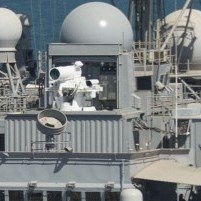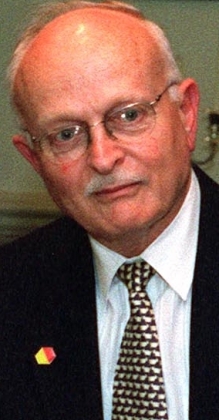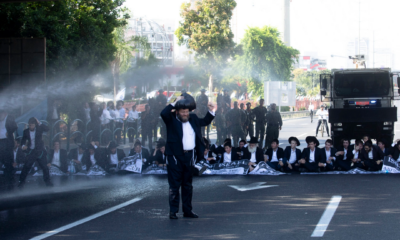
Banner

Beats Iron Dome -Boeing Israel head
ANT KATZ
After the US Navy’s successful battle tests of a laser interceptor, a former Israeli air force chief, Maj-Gen (res) David Ivry, says the system may be a more potent, faster, and less costly alternative to antimissile arsenals like Iron Dome. Ivry who was the ninth Israel Air Force chief between 1977 and 1982, has also headed Boeing Israel since 2003.
He was among the original brains behind the long-range Arrow ballistic missile, which, along with the mid-range David’s Sling and short-range Iron Dome, are slated to provide Israel with a tiered defence system against an estimated 100 000 rockets in the hands of Lebanon-based terror group Hezbollah, not to mention Hamas in Gaza, Iran, and other non-state actors.
“Laser is a multi-role system – like a fighter aircraft. You can deploy it on the ground, on board an aircraft, on a Jeep or on an armoured vehicle. It can intercept aircraft, missiles, artillery shells and UAVs,” said Ivry this week.
Israel concerned at what may lie ahead
While Iron Dome more than proved its abilities in knocking hundreds of Hamas-fired rockets out of the sky during Operation Protective Edge, Israeli government and defence ministry officials feel that even with Iron Dome’s 90 per cent success rate against smaller Grads and Qassam rockets, these could be child’s play compared to what may lie ahead in future conflicts.
“The Iron Dome system has inherent capabilities that were not fully tested either in Pillar of Defence or in Protective Edge where, with all due respect, we were dealing with Hamas,” according to Yosi Druker, Rafael’s general manager of the Air Superiority Systems Division.

PIctured at RIGHT is David Ivry in the early 2000s – when he was the Israeli Ambassador to the US
The 735 intercepts of the Gaza rockets fired toward populated areas was a serious and sustained improvement over earlier software and hardware versions used in Pillar of Defence two years ago, officials are concerned that it still won’t be enough to successfully deal with far more massive fusillades by heavier munitions.
“In the context of Lebanon, it will be something different,” Druker said.
The Iran-backed Lebanese Shi’ite group’s leader, Hassan Nasrallah, vowed in a recent address that the weapons would hit all of the State of Israel in a future conflict, including Tel Aviv.
Their massive arsenal of rockets is reportedly mostly hidden throughout south Lebanon.
While Israel is aware of most of the locations, they say, they are beneath houses, schools, clinics and hospitals and difficult to attack.
Iron Dome won’t cope with Hezbollah attack
“Ben-Gurion International Airport would have to be shut down from early on in the fighting against Hezbollah,” an official told Israel Hayom at the end of October. “Iron Dome won’t be able to duplicate its interception rate from Operation Protective Edge.”
Also, at the cost of up to $100 000 for each Tamir interceptor, it’s an expensive response, even though the missiles are GPS-synched to only fire when the incoming munition is headed for predefined populated areas,
The system may be overwhelmed by dozens of incoming salvos of rockets, fired at once to overcome Iron Dome’s ability to track divergent targets simultaneously.
On the other hand, as Ivry noted, “under fog or heavy cloud conditions… the laser beam is distorted and becomes ineffective. These are the situations that should be complemented by Iron Dome.”
Using Israel’s gateway Ben-Gurion Airport as an example, he pointed to the particular civil aviation threat, which, did, in fact, briefly shut down flights in July, and caused intermittent rerouting to alternate flight plans – a move which even scared off some carriers.
Deploy both laser & Iron Dome
“You do not want anything dropping there under any circumstances. If even one rocket should hit that airport, no airline will land there. This is the place where you should deploy both the laser weapon system and the Iron Dome system,” Ivry said, pointing to the “$5 000 or less” price tag per light punch.
Comparing the divergent defence systems, Ivry noted that “in order to shoot down Katyusha rockets from a range of 15-20 kilometres, you need a power output of 100 kilowatts. Today, with a solid-state laser, you can reach output rates of 30-40 kilowatts – depending on the manufacturing country. No one states exactly what they actually have, but it is certain that all of them have reached 10-15 kilowatts. So, you connect a few of those and obtain the output you need.”
Navy officials at the Office of Naval Research, said on December 10 that the laser weapon system (LaWS) mounted on the USS Ponce “locked on and destroyed the targets we designated with near-instantaneous lethality”.
The Americans are in no hurry
Ivry noted that “in ’96 we began developing the Nautilus as a prototype. We deployed a system in Kiryat Shmona (Israel’s northernmost city, and alongside the Lebanese border).
“If you want to shoot down a Katyusha rocket, you need to penetrate its outer shell. For this you have to keep the beam on the same point for two seconds,” he explained. “This is the challenge.”
Israel had proven on targets including mortar and artillery shells that if one can establish a connection between radar and a self-aiming system and then one can achieve successful results.
“If you have 100 kilowatt output, you will have a solution for all of the Katyusha rockets. In the US they are in no hurry as no one fires Katyusha rockets at them. They do not face the threats Israel faces,” explained the Boeing Israel head.
Less than $1 a pop
But, says US Rear Admiral Matthew L Klunde:, “Laser weapons are powerful, affordable and will play a vital role in the future of naval combat operations.
“At less than a dollar per shot, there’s no question about the value LaWS provides,” said Klunder.










